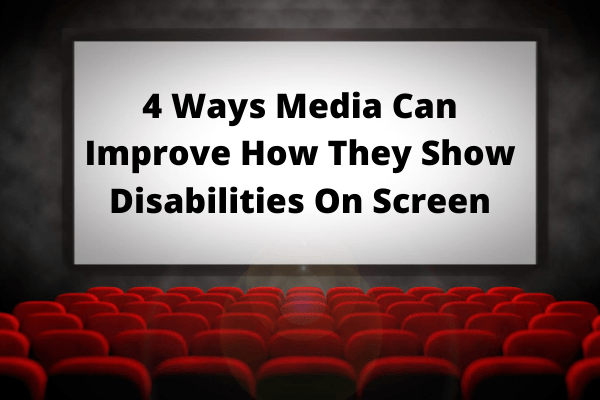4 Ways Media Can Improve How They Show Disabilities On Screen

Another convention has passed without much discussion of a nagging issue: how show runners depict disabilities on screen. Good representation is so important, and so simple. We spoke with some experts in the field to come up with five ways entertainment media can up their game when it comes to handling disabilities on screen.
Editor’s note: Elements of this article were originally planned as part of a 3-part inclusion and accessibility series, all timed to coincide with convention season. With all the cancellations this year that schedule has been interrupted, but we still wanted to share insight from these amazing panelists.
During this past weekend’s SDCC@Home we got a look at what’s coming up in entertainment. Some of it was good news, especially hearing that The Dragon Prince (and its beautiful handling of a canon Deaf character) has been greenlit for the entire rest of the saga. The rest… Well, there just wasn’t much discussion of disabilities in media at all.
I did catch Diversity and Comics: Why Inclusion and Visibility Matter. There’s some good discussion there about why inclusivity matters. A panel about how fandom is helping people get through the pandemic (“Crazy” Talk: Mental Health, Pop Culture, and the Pandemic) also touched on representing mental illnesses responsibly. That’s awesome (and you can see both panels at those YouTube links).
The thing is, these panels were mostly about why it’s important to show disabilities. I didn’t see a solid discussion on how to write disabilities for the screen, and where show runners are going wrong. With so many “how to” panels, why wasn’t this subject included?
Fortunately, we have some solid insights from last con’s “DisSDCC: Representation Inclusion Accessibility” panel. Here are some tips from the experts on how media can handle disabilities on screen more inclusively:
Cast disabled actors to play disabled characters.

The best person to play a character with disabilities is an actor with that disability. This seems absolutely basic, but we’ve all heard how hard John Krasinski had to push to cast Millicent Simmonds in A Quiet Place. Kai Winchester expressed his frustration with how rarely producers get something so simple wrong, even when advised otherwise.
“On Emily Blunt’s movie as a blind woman there’s a consultant on the movie who is blind.[Editor’s note: Blunt was attached to Not Fade Away, a biopic of Rebecca Alexander, which has since apparently been dropped from production.] They decided to place a not-blind person in the role even though the consultant said no before they went on with the movie. So… what was the point placing the blind consultant or disabled person to ask for their help if you’re not going to follow what they say?”
It isn’t enough to seek advice from actors and consultants with disabilities – you have to actually listen to their feedback.
What we hear from disability consultants is that they’re often ignored when their advice is inconvenient. If a script calls for a disabled actor to read lips across a crowded room, for example, a consultant would probably point out that lip reading isn’t perfect and that range complicates things. Often, directors dismiss those concerns instead of rethinking the scene.
Cindy Kapp, who organized the 2019 DisSDCC panel, explained how disabled actors are pressured to go along with this kind of misrepresentation. “The writers say, ‘You have to do these things.’ And the actor’s like, ‘Wait, that’s not really representative of my real life.’ [They] have 2 choices: follow the script and get paid for the work [the director] wants you to do, or complain and get fired. Then you see the scene on TV and think, that doesn’t go, that doesn’t match, that doesn’t fit.”
“I don’t think the audience always realizes that the actors are in a tough position,” she continued. “They have those 2 choices: you either follow the scripts and the writers and the studios so people like the story and studio, and there’s some improvement there [Editor’s note: improvement in the number of characters with disabilities on screen], or you complain and get fired after protesting against it. Those are the only two things that happen. You sit there in the audience as a disabled person and go, ‘I’m not happy with that’. And obviously, it’s not that disabled person’s fault.”
Make room for creators with disabilities to take the lead on storytelling.
When people outside a group create work about a group on their own, the stories tend to fall into very narrow categories.
Panelist Emy Cook said, “I’d just like to see more media, more films, more TV series, created by people with disabilities, because what I see a lot in the media are disabled story lines that become somewhat of a tragedy, or the character is a token character. I don’t think that’s the way our world is. We’re living people and that’s the way we should be seen on screen. I think it’s unfair that we don’t get to see ourselves represented any other way than a pity story, a triumph story. When you have a disabled character portrayed by an abled actor it perpetuates the stereotype that we are the type of person that deserves an award just for being alive.”
Cook did bring up a show they felt had surprising representation: CW’s Crazy Ex-Girlfriend. “It’s the first time I’ve seen a character who has a mental illness, who went through an entire arc of a diagnosis, to a denial, to an acceptance. And it was so accessible to people who maybe did not live through those experiences and it was also a way to start conversations and erase stigma, and Rachel Bloom has made it a point to take not only her own personal experiences in the writing, but using other voices, and making sure that their voices were seen on screen. And I feel like with mental illness, that’s something that doesn’t happen a lot so I was very excited to see that.”
Stay away from harmful sterotypes.

There’s something worse than having no representation: having representation that’s actively harmful to how those with disabilities live their lives. One example would be a character with a service dog who is allowed to play around while working. Another is showing characters with PTSD as unstable people who might become dangerous at a moment’s notice. Reinforcing these negative stereotypes makes is harder for people with disabilities to go about their everyday lives.
Kapp’s pet peeve is forgetting that ambulatory wheelchair users exist. “Half the time, if you see someone in a wheelchair they’re always using a wheelchair. If you see them get up and walk a little then they’re faking it. It makes things worse for me when, say, I left my scooter over there and walked over here because it’s easier. Every time you see a wheelchair user walking on TV it just reinforces the stigma against ambulatory wheelchair users – that no matter what, we’re always faking. Same with people with invisible disabilities.”
This plays into our final point, which is…
Remember that disabilities exist on a spectrum.
There’s no “one way” to be disabled. Disabilities present with a variety of symptoms, and two people with the same disability might have different needs. When show runners include disabled characters, though, they usually stick to what audiences expect to see. Blind characters have zero vision. Deaf characters have no hearing at all.
It’s a problem for those who live outside that narrow stereotype, Winchester explains. “[Imagine] you can hear a little bit, or maybe you’re not fully Deaf and you need hearing aids, or you have an auditory processing disorder. You can hear, but you can’t understand what you hear. So that’s an invisible disorder. But if you say, ‘I have APD, I need an interpreter or close captioning,” and a person starts speaking to you and you answer, they say, ‘Obviously you’re not deaf, you don’t need an interpreter.’ ”
A more realistic depiction of disability should include a spectrum: visually impaired characters who see light or colors, characters who only use a wheelchair during symptom flares, and so on.
None of these tips would be very hard to incorporate into normal media development. Better, using them would create more interesting stories in general. Let’s hope that as more creators with disabilities make their way into positions of authority at studios and behind the camera, TPTB will start listening to them.
Author: Khai
Khai is a writer, anthropologist, and games enthusiast. She is co-editor (alongside Alex DeCampi) of and contributor to “True War Stories”, a comic anthology published by Z2 Comics. When she’s not writing or creating games, Khai likes to run more tabletop RPGs than one person should reasonably juggle.
Help support independent journalism. Subscribe to our Patreon.
Copyright © The Geekiary
Do not copy our content in whole to other websites. If you are reading this anywhere besides TheGeekiary.com, it has been stolen.Read our







I’m just glad to see anyone taking into consideration people with disabilities.